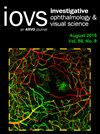黄斑水肿间质流和视网膜组织变形的数学模型
IF 5
2区 医学
Q1 OPHTHALMOLOGY
引用次数: 0
摘要
目的 本研究旨在建立一个数学模型来阐明视网膜中的液体循环,重点是间质(包括水和白蛋白)的运动,以了解渗出性黄斑水肿(EME)的基本机制。方法 该模型综合了视网膜色素上皮(RPE)泵、渗透压梯度和组织变形等生理因素。结果该模型预测,尽管其他部位的毛细血管有液体渗出,但眼窝中心的组织变形最大,这与临床观察结果一致。此外,该模型还表明,HC 在视网膜厚度上的空间变异性对眼窝的液体积聚起着保护作用。结论尽管参数值存在固有的简化和不确定性,但这项研究代表了向理解 EME 病理生理学迈出的一步。研究结果深入揭示了视网膜流体动力学和眼窝区流体积聚的内在机制,表明Müller细胞的特殊构象可能起着关键作用。本文章由计算机程序翻译,如有差异,请以英文原文为准。
A Mathematical Model of Interstitial Fluid Flow and Retinal Tissue Deformation in Macular Edema.
Purpose
This study aims to develop a mathematical model to elucidate fluid circulation in the retina, focusing on the movement of interstitial fluid (comprising water and albumin) to understand the mechanisms underlying exudative macular edema (EME).
Methods
The model integrates physiological factors such as retinal pigment epithelium (RPE) pumping, osmotic pressure gradients, and tissue deformation. It accounts for spatial variability in hydraulic conductivity (HC) across the retina and incorporates the structural role of Müller cells (MCs) in maintaining retinal stability.
Results
The model predicts that tissue deformation is maximal at the center of the fovea despite fluid exudation from blood capillaries occurring elsewhere, aligning with clinical observations. Additionally, the model suggests that spatial variability in HC across the thickness of the retina plays a protective role against fluid accumulation in the fovea.
Conclusions
Despite inherent simplifications and uncertainties in parameter values, this study represents a step toward understanding the pathophysiology of EME. The findings provide insights into the mechanisms underlying fluid dynamics in the retina and fluid accumulation in the foveal region, showing that the specific conformation of Müller cells is likely to play a key role.
求助全文
通过发布文献求助,成功后即可免费获取论文全文。
去求助
来源期刊
CiteScore
6.90
自引率
4.50%
发文量
339
审稿时长
1 months
期刊介绍:
Investigative Ophthalmology & Visual Science (IOVS), published as ready online, is a peer-reviewed academic journal of the Association for Research in Vision and Ophthalmology (ARVO). IOVS features original research, mostly pertaining to clinical and laboratory ophthalmology and vision research in general.

 求助内容:
求助内容: 应助结果提醒方式:
应助结果提醒方式:


